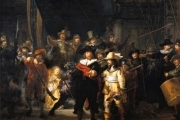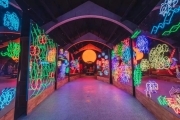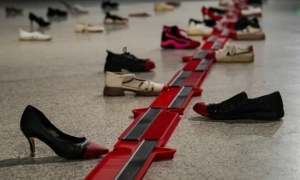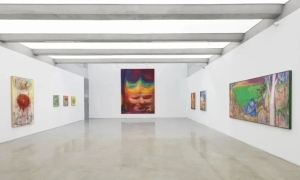囚-047 150×150cm Acrylic on canvas 2007
2006年春,在成都郊外蓝顶艺术区,笔者第一次见到这组以“囚”命名的系列作品,由此而认识罗杰,一位语速平缓、气质温和,略显腼腆的艺术家。后来得知,罗杰当时刚刚进驻‘蓝顶’,拥有一间向往多年的工作室,其独特的个人创作风格也在这一时期得以形成,并延续至今。
相隔三年,我仍清晰记得初遇作品时的惊觫:肉身异化成粗砺纠缠的绳索,精神依然徘徊其中,咆哮冲撞,焦灼痛楚,又时有冷漠和凄惶。无论是危险不安的暴力场景,还是疏离疲惫的肢体语言,都令人困惑难解。又因似曾相识,更添遐想与恐惧。这种特殊而异样的视觉经验,从何而来?如果从发生学角度考量,图像生成乃是根植于个体的生命体验,那么,如何检索、唤醒及呈现潜伏的个人记忆,并把它转换成有意义的视觉表达,使其在当代社会文化情境中,具有特殊的符号学意义呢?基于此,我对罗杰的作品产生了兴趣。
罗杰就读四川美术学院期间,正值中国当代艺术的转折点,——上世纪八十年代末九十年代初期,新潮美术因政治事件嘎然而止,中国当代艺术陷入沉潜期。此时,四川美院创作处境微妙:一方面,油画创作总体上与当代艺术并不相交,日益商业化的风情写实与日益主流化的乡土叙事相互助长,一度被港台画商所操纵。另一方面,四川美院当代艺术的个体探索并未停滞,并以其边缘、地下的方式持续进行。如张晓刚、叶永青、陈卫闽、杨述、张濒、忻海洲、郭晋等。更重要的是,从1991年开始,四川美院批评家王林逆流而行,策划组织中国当代艺术研究文献资料展,并发起对于“八九后艺术的讨论”,提出了包括“政治波普”在内的一系列艺术概念。这项活动延续十年历经六届,集中呈现了中国八九后艺术的创作倾向,并动员国内批评力量深入研究当代艺术问题与八九后中国美术现状,对中国当代艺术的发展影响深远。以上三条线索,大致可以勾勒出罗杰当年身处的学习环境:沉闷、压抑,却不乏独立精神和批评锋芒。当然,还有学院门口不时辗过的坦克车,和新近生产的防暴车。这里靠近兵工厂,公路也是军械实验的道路。
这段时期,留给罗杰的生命记忆,对其后来创作的影响是巨大的。究其画面,至少有三点值得探源:
其一是其表现主义倾向。中国当代艺术明显的表现主义创作倾向,汲取西方现代艺术成果转向直面本土社会及历史问题,寻求充满中国经验的话语表达。其价值在于,敢于直面当代人的心理矛盾、精神冲突及个体生命对生存异化的反抗。同时,关注社会意识形态变化,揭示隐含其间的现实问题。至世纪之交,中国当代艺术的先锋精神面临着消费文化、权力资本和后殖民文化的侵袭,因利益共谋而将表现主义创作加以遮蔽。2006年前后,罗杰反其道而行之,其“囚”系列作品,深入内心揭示精神苦难,表达了对中国历史、社会和个人曾经历过的和正在经历的现实体验。这里有的是艺术良知和艺术家的尊严,而不是名利场逻辑。
其二是作品的象征性转喻。罗杰运用置换手法,让非物质的物质性与物质的非物质性之间产生歧义。其人物造型,并非鲜活的肌体,而是一具具用粗绳捆绕的活动模具,有着属人的表征却是被异化了的‘生物’。其作品把日常发生的情景进行陌生化处理,使之悬置于后工业化时代特有的冰冷时空中,从而让阅读者遭遇到文化、社会、现实的种种问题。象征性转喻不仅体现了画家强烈的个人情感,也体现了作者鲜明的批判性。同时,也是艺术家转换写实手法使之具有观念性的绘画方式。
其三是关于作品的个体化表达。如果说,生命体验和生存经验的相互开启是当代艺术创作存在个体化的基础,那么,罗杰的生活际遇则是其独特表现语言的诱因。罗杰毕业之后,迫于生活压力,独自南下谋生。结果可想而知。九十年代初期的深圳,物欲膨胀,就连空气也散发着铜臭味儿。每天高强度劳动过后,罗杰再也不想和这座城市发生任何关系,躲进书堆,寻找慰藉。正是这一时期,罗杰渐渐养成了文字书写的习惯和独立思考的能力。而看似枯燥的工作,也令其颇有受益,即对绘画材料性能的熟练把握。工作中用的全是荷兰进口颜料和日本动画纸,这对罗杰而言,可是货真价实的奢侈品啊!但陌生的环境让他倍感孤独,甚至出现忧郁症倾向。1993年,罗杰怀揣两万块钱回到西南,还是想当艺术家!在重庆遇到了赵能智,封胜,何森,陈文波,杜侠等美院毕业的同学,后来又到了成都。一晃过了两年,罗杰花光了积蓄,无法支撑画画所需的基本开销,于是只能在成都杜甫草堂边上住下,画些小稿,生活毫无着落。画废了的纸张罗杰舍不得扔掉,用笔一遍遍地在上面重复勾勒涂抹。有一天,突然惊觉,这些线条怎么像父亲编织的渔网,这突如其来的记忆一下启发了他。
罗杰的父亲是一位孤独善良却脾气暴躁的男人,一生守护在青藏高原阿木柯河道班,是红原县318国道上的养路工人。为了远方妻儿补贴家用,经常编织渔网,捕鱼卖鱼。但有一次父亲骑自行车外出捕鱼,被一辆货车撞伤,再也不能站起来了。这位孤身流放的‘囚徒’因此回到家中。罗杰经常看到他坐在院子里,靠在椅子上编织着渔网。父亲离家日久,似乎忘了如何与家人交流,编织渔网是一种无需表达的生活方式,是其生命存在的唯一寄托与慰藉。自卑而又倔强的父亲,只有在编织渔网时,心灵才得以平静。那张永远也编织不完的鱼网,与父亲牵连了一生,深深嵌入罗杰的生命记忆中,成为其生命必须承受之重!
这样,一根线的无止无休的缠绕出现在罗杰的作品中,这就是他的作品“囚”系列。一方面,画面语言呈现于视觉充满了丑陋、毁灭与撕裂等负面的心理暗示;另一方面,潜藏在罗杰内心深处强烈的修复欲望却不知不觉地被牵扯出来。父亲对爱的追寻,体现在对渔网周而复始的编织中,渔网对他而言,实用功能已退居其次。而罗杰在作品完成过程中,在编织纷繁复杂的绳索时,同样是在修复着无法忘却的伤痛。与父亲静态修复不同,罗杰属于动态修复,是艺术家把个体的经历与苦难,放置在一个历时性的时间维度及共时性的空间背景中,思考个体与社会之间的历史关系,反省人在有限的生命历程中必须面对的文化制约,由此产生的批判精神。从2006年创作开始,“囚”系列作品从反抗激情和场景化的强烈冲突逐渐让位于个体化的复杂细腻的心理矛盾,如作品《敏感者》、《抽烟的人》、《哪里会是象牙塔》等。画面构成和人物刻画则愈见简练,看得出来,罗杰更倾向于敏感的体悟和开阔的视野,来审视当代人所面临的精神问题。
郑 娜
2009年4月11日
写于二沙岛广东美术馆
The Story of a Mind Mender
In the spring of 2006, at the Landing Art Quarters in the outskirts of Chengdu, I saw the series of works named Imprisonment for the first time and subsequently got acquainted with Luo Jie, a slowly-speaking, mild-tempered and somewhat timid artist. Later, I got to know that Luo Jie had just come to and settled down at Landing to have a studio he had been dreaming of for many years. His unique style of artistic creation also took shape in this period and remains unchanged till now.
Three years have passed, but I still remember distinctly the shock to me when I saw his works at the first sight--- rough ropes tangling together are incarnation of human bodies, whose souls are still lingering around, roaring and rampaging, full of anxiety and agony, and sometimes coldness and confusion. Everything is bewildering, from the disturbingly perilous and violent scenes to the body language representing alienation among and tiredness of people. The seemingly familiar scenes add to fancy and fear all the more. Where has this kind of special and strange visual experience come from? From genetics perspective, the generation of images is rooted in individual experience of life. Then, how to retrieve, awake and present dormant personal memories and transform them into meaningful visual expressions so that they can bear some special symbolic meanings under present social and cultural circumstances? To find an answer to this question, I got interested in Luo Jie’s works.
The contemporary Chinese art was just at a turning point while Luo Jie was studying in Sichuan Fine Arts Institute (SFAI). At the turn of the 1990s, the modern fine arts movement came to an abrupt end because of political events, and the contemporary Chinese art sank into a dormant period, during which the creative atmosphere at Sichuan Fine Arts Institute was very delicate. On one hand, oil painting creation was largely irrelevant to modern art. On the other hand, two painting styles, namely the realistic style, which was ever-increasingly commercialized, and the narrative style, which was ever-increasingly becoming the mainstream, fostered each other. The market was once prevailed by painting dealers from Hong Kong and Taiwan. On the other hand, exploration into modern art by individuals, such as Zhang Xiaogang, Ye Yongqing, Chen Weimin, Yang Shu, Zhang Pin, Xin Haizhou and Guo Jin, etc., never stopped at SFAI but proceeded in a marginal and subtle way instead. More importantly, in 1991, Wang Lin, a critic from SFAI, going against the general trend, planned and organized the Exhibition of Chinese Contemporary Arts For Study, initiated the “discussion on post-1989 art”, and put forward a series of artistic concepts including “political pop art”. It has been 10 years since the inception of this movement and there have been 6 exhibitions, collectively presenting the tendencies in post-1989 art creation in China and encouraging domestic critics to explore the problems with contemporary art as well as the current state of the post-1989 Chinese fine arts. These activities have produced a far-reaching influence on the Chinese contemporary art. With the above three clues, we can basically sketch out the academic environment for Luo Jie at that time: a dull and depressing one, but with the spirit of independence and criticism. Of course, there were also tanks roaring past the gate of the institute and the newly built anti-riot vehicles. This place was near an arsenal, and the roads were also used for the test of ordnance.
The memory of this period in life had a significant influence on Luo Jie’s later creative work. Looking at the images, there are at least three points worthy of deep exploration:
The first is his expressionist tendency. The contemporary Chinese art has an obvious expressionist tendency, and changed from drawing upon the fruits of western art into braving local social and historical problems in quest of an expression full of Chinese experience. Its value lies in its bravery in facing the psychological and spiritual conflicts as well as the opposition by individuals against existence alienation. At the same time, it pays attention to the changes in social ideology and tries to disclose the actual problems hidden behind it. At the turn of the century, the avant-garde spirit of the contemporary Chinese art was facing the encroachment by consumption culture, power capital and post-colonialist culture. Expressionistic creation was overshadowed by conspiracy of interests. Around 2006, Luo Jie did the contrary to the current and expressed the actual experience that had been experienced and was being experienced by China history, society and individuals by exploring deeply into the heart and disclosing spiritual miseries with his series of works named Imprisonment. What dominate his works are the conscience in art and the dignity as an artist rather than “vanity fair” logic.
The second is the symbolic metonymy of his works. Luo Jie is good at transposition, creating misunderstandings between the materialness of non-material and the non-materialness of material. The figures are not lively bodies but moving carriers wrapped up in thick ropes, transformed “creatures” with the external features of humans. In his works, everyday scenes are treated as strange situations, suspended in the cold space unique to the post-industrial era, so that the audience can encounter various problems in the cultural and social reality. This kind of symbolic metonymy not only embodies the strong personal feelings of the artist but also his clear criticism. At the same time, it is also a shift from the realistic painting style to one with conceptual characteristics.
The third is about the individualized expression of works. If the communication between the experience of life and that of survival is the basis for the existence of individualization in artistic creation, then the turns in Luo Jie’s life are the causes of his unique expression. After graduation, Luo Jie went to the South for a living by himself. The result is imaginable. In Shenzhen at the early 1990s, people’s material desires were swelling, and even the air smelt of the stink of money. After hard labor every day, Luo Jie would not have any relationship with this city; instead, he buried himself in books and tried to find comfort from them. It was just during this period that Luo Jie formed the habit of writing and independent thinking. And he also benefited from the seemingly monotonous work—that is, he developed a skillful command of the features of painting pigments. What Luo Jie used in his work--imported Dutch pigments and Japanese animation paper—was bona fide luxury products for him. But the strange environment also made him extremely lonely. He even showed symptoms of melancholia. In 1993, Luo Jie came back to the Southwest with 20,000 yuan in hand, still dreaming of becoming an artist! In Chongqing, he met He Sen and spent some time painting together. Then he came to Chengdu. Two years passed in a flash. When Luo Jie used up all his savings and could no longer afford the basic expenses for painting, he had to move to stay temporarily near the Du Fu Thatched Cottage in Chengdu and support himself by paining some petty works, with no stable sustenance. Luo Jie was reluctant to throw away the waste paper and he would sketch and scratch on it once and once again. It was not until one day did he suddenly realize that there was great similarity between the lines and the fishnets his father had once knotted. This abrupt awakening of memory inspired him all at once.
Luo Jie’s father was a man of loneliness, goodness but hot temper. He has been guarding the Amuke watercourse shift on Qinghai-Tibet Plateau all his life as a maintaining worker of National Highway No. 318 in Hongyuan County. He often wove fishing net, went fishing and sold fish to earn more money to support his remote family. Unfortunately, his father was hurt by a truck on the way to fishing by bike and he could not stand up any longer. Thus, the solitary “Prisoner” went back to his home. Luo Jie used to see him sitting in the court and weaving fish nets on the chair. His father seemed forgetting how to communicate with the family due to long period away from the family. Weaving fishing net was a kind of life style without expressing and was the only bailment and consolation of existence of the life. The self-abasement and hard-nosed father felt calm in spirit only when weaving fishing net. The fishing net that can’t be completed forever involved in the life of his father and left permanent memory to Luo Jie as a heavy burden in Luo Jie’s life.
Thus, an endless-winding fishing thread appeared in Luo Jie’s works. This is his series of works named Imprisonment. On one hand, the image language took on negative psychological implication full of ugly, destruction and avulsion visually. On the other hand, the strong desire for mending in the deep mind of Luo Jie broke out unconsciously. The father’s pursuit for love was reflected from endless weaving of fishing net. The practical function of the fishing net was not the most important for him. When Luo Jie created his work by weaving the confused and complicated threads, he mended the unforgettable pain. Unlike his father’s static mending, Luo Jie dynamically mended the pain by placing the artist individual experience and suffering in a historical time dimension and a synchronic space background, considering the historical relations between individuals and the society and reviewing the critical spirit generated from the culture constraints that one must face with in the limited life course. Since 2006, in the series of works named Imprisonment, the rebellious passion and strong scene-like conflicts had been gradually replaced by complex and delicate individualized psychological conflicts, like in such works as the Sensitive Person, the Smoker and Where is the Ivory Tower?, etc. The composition of the images and the depiction of figures are becoming more and more succinct. It can be seen that Luo Jie is more inclined to examine the spiritual problems that contemporary people are facing.
Commented by Zheng Na at Guangdong Museum of Art
April 11, 2009
【编辑:小红】























